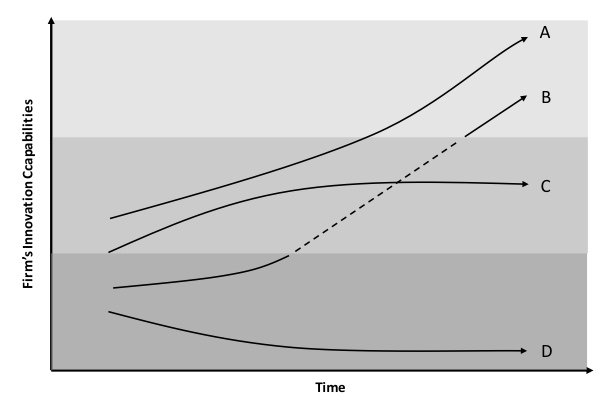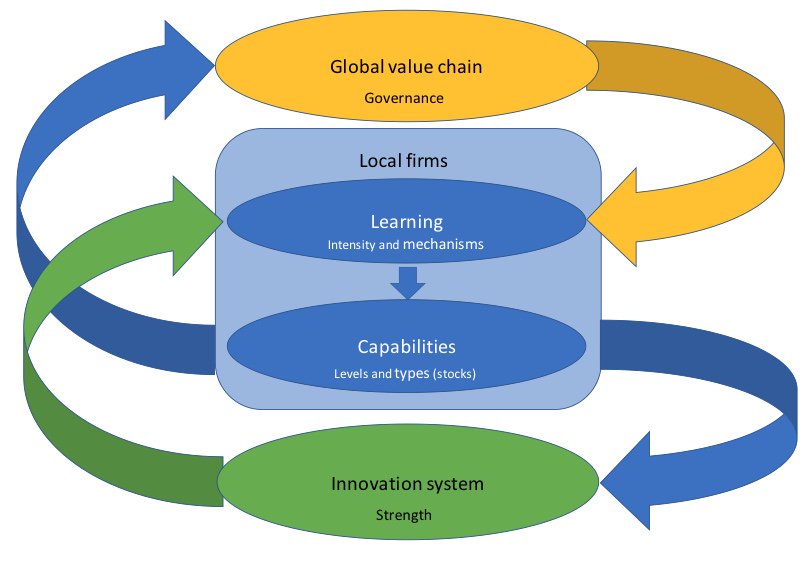By Padmashree Gehl Sampath (UNCTAD), Rasmus Lema (Aalborg University) & Roberta Rabellotti (Università di Pavia & Aalborg University)
The increasing involvement of developing countries in Global Value Chains (GVCs) when supported by well-developed Innovation Systems (ISs) could influence the building of technological and innovation capabilities of their firms and sectors. Introducing the notion of co-evolution of global value chains and innovation systems to reflect this dynamic, we propose some illustrative trajectories for learning and innovation. The trajectories proposed are supported by examples that offer up evidence on improvement in local innovation capabilities with potentially positive effects on overall competitiveness, but also cases in which there is little progress or even a loss of previous innovation capacity.
Learning and innovation in GVCs
Involvement in Global Value Chains (GVCs) can offer opportunities for learning, production and innovation capabilities building in to domestic enterprises located in developing countries. The governance patterns dictate how chains are organised and how power is distributed within the hierarchy, thereby shaping the opportunities, and the direction and speed of building domestic capabilities. Multiple relationships between the actors involved in GVCs, predominantly the lead firms and the supploers, have a heterogeneous impact on how learning occurs within chains. For instance, learning can be the result of pressure to match international standards. In such cases, when the competence of suppliers is low and the risk of non-compliance is high, learning may be facilitated by direct involvement of the value chain leaders. Alternatively, when the actors in the value chain have complementary competencies, learning can be mutual and based on intense face-to-face interactions.
Developing country innovation systems in the global economy
While GVC involvement provide venues for external knowledge that is critical for learning and innovation, it is important that firms possess absorptive capacity, namely the ability to exploit both externally acquired knowledge as well as domestic knowledge. Such absorptive capacity dictates the extent to which external knowledge finds expression in the activities at t the firm-level, and also promotes knowledge diffusion within the innovation system in which the firms are embedded.
The innovation system (IS) approach pays attention to these attributes of learning, knowledge creation and diffusion that leads to capabilities building. Although developed originally from the study of advanced economies, the role of innovation systems in developing countries has received increasing attention over the past two decades, where they are often characterised by weak and fragmented relationships amongst enterprises and between enterprises and supporting innovation institutions, particularly those responsible for public research. Therefore, in developing country innovation systems, typically sources of domestic and international knowledge matter for learning, and GVCs have become an increasingly important source for the latter in the past decade.
The co-evolution of global value chains and innovation systems
In a recent paper, we investigate how combining global value chain and innovation system approaches can build technological capabilities in developing countries. We outline possible trajectories through which learning and innovation may take place in developing countries. Although there have been prior attempts to bring these frameworks together for theory building and empirical analysis, our work aims to foster a better understanding of these channels of interaction, and calls for more work in the future to explore the precise dynamics involved. We advance the proposition that while GVC and IS approaches complement each other by helping to address the relationships with (different) actors that impact the process, on their own, neither framework is sufficient to provide a full understanding of the underlying dynamics.
To bridge existing gaps on how GVCs and IS interact in developing countries, we propose a conceptual framework to investigate the co-evolutionary relationships in which local firms are involved with global value chains and innovation systems, the key elements of which are summarized in the Figure 1.[i] There are flows (yellow and green arrows) indicating how GVC and IS contribute to the accumulation of firms’ capabilities and learning processes, as well as feedbacks (blue arrows) that identifies how global value chains and innovation systems co-evolve, thanks to their interactions with local innovative firms and their evolving capabilities.
The interactions between global value chains and local firms (yellow arrows) can involve knowledge about product requirements in the global markets, technologies (know-how, licenses or other means), organizational models and even direct support from the leading GVC companies, depending on the main governance patterns. Subject to the strength of the system, the flows between the innovation systems and the local firms (green arrows) could provide specialised skills and knowledge, extension services such as metrology, standard certifications or incubation services, financial resources, and local research inputs mainly based on adaptations of existing knowledge.
The blue arrow (left side) indicates that changing local firm capabilities influence where and how they can engage in different types of GVCs (e.g. in different markets), considering their competitive dynamics. Changes in local firm capabilities, arising from local and global learning processes, may influence the governance structures of GVCs, including the sourcing strategies of the lead firms. On the right side, the blue arrow points to the relative stock of capabilities in local firms inserted in GVCs that influence the evolution of the innovation system. This may happen because of the demand for different types of knowledge and resources in the education and science system or because of specific services offered by quality and standard agencies, business associations, etc.
It should be noted that there is no automaticity in these interactions and their effects. The specific nature of co-evolution of global value chains and innovation systems will also vary greatly, depending on an assortment of macro and micro factors. These include the level of development and governance capacity of the country, the macroeconomic context, the trade policy framework, the main market segments, the existence and development of other external channels (e.g. FDI, human capital mobility, direct exports), the technological characteristics and knowledge bases of the predominant sectors and the characteristics of local firms (e.g. size, openness, presence of knowledge gatekeepers, level of formality).
GVC-IS Co-Evolution and Firms’ Innovative Processes
Source: Lema. Rabellotti and Gehl Sampath 2018
Illustrative trajectories
There are four hypothetical trajectories of GVC-IS co-evolution: (a) the gradual, (b) the in-out-in, (c) the aborted and (d) the retrograding trajectories as depicted in the Figure below. Then, the Table presents some possible trajectories for the changes in a firm’s innovation capability offers a summary of their main characteristics with reference to the main features of global value chains and innovation systems.
The gradual trajectory results from a positive co-evolution between GVCs and ISs and it occurs when the local innovation system has the prerequisite strength and the value chain characteristics allow for knowledge flows and interactive learning. The literature offers several examples in which such pathways have been forged, not least in large middle-income countries with relatively high governance capacity. An example is offered by a recent special issue article published in the European Journal of Development Research by authors Humphrey, Ding, Fujita and Hioki (2018), who shed light on some of the factors that can support the emergence of a gradual trajectory. They show the rapidity and complexity of technological change – either due to the technology characteristics of some sectors (technology push factor) or the nature of demand (demand pull factor) – and how it can create opportunities for more intense interactions between global value chains and innovation systems. They analyse the drivers of product differentiation and innovation in two very different sectors in China (mobile phones and electric two-wheelers), highlighting the role of policy in supporting the GVC-IS co-evolutionary trajectory. The authors note that although changing customer demand created the pressure to improve functionality and quality of products in the Chinese market, in both sectors, public policy supported the development of capabilities. The electric two-wheeler sector expanded rapidly due to governmental restrictions on gasoline-led motorcyles. So, although the technological change was much slower, the domestic policy helped Chinese firms to secure greater shares of an expanding market by investing greater R&D capabilities while, at the same time, benefiting from extensive support from the national innovation system. In the mobile phone sector where technological change was rapid and of a disruptive nature, firms similarly benefited from public policies that supported capabilities development. Their findings reinforce how firm-level and publicly led investments in innovation capabilities work together to promote innovation.[ii]
Illustrative trajectories of firms ‘innovation capabilities
Source: Lema, Pietrobelli and Rabellotti (2018)[iii]
The in-out-in trajectory may unfold if the innovation system is relatively well developed, but GVCs are characterised by limited learning opportunities. Lee, Szapiro and Mao (2018) present evidence supporting this trajectory, using cases of Korean and Brazilian firms.[iv] They suggest that participation in the GVCs is necessary to acquire foreign knowledge and production skills in the preliminary development stage (b) separation and independence from existing foreign-dominated GVCs is required for functional upgrading at mid-level stages and that (c) latecomer firms and economies need to reintegrate into the global chain after establishing their own local value chains, ultimately reaching the maturity stage. According to them, new technologies, and more precisely short-cycle technologies that rely less on existing knowledge stocks, offer better opportunities for latecomer countries to achieve world-class competence.
The aborted trajectory may occur if the innovation system is relatively weak and fragmented and the value chains do not provide access to critical knowledge, resources and pressure for learning. In this case, local firms remain stacked and learning rates are slow because knowledge does not transmit or spill over from GVC enterprises to the wider innovation system, due to limited local absorptive capacity. An example is offered by Ponte et al. (2014), who investigate the aquaculture chains in four Asian countries, finding that – in contrast to producers in China, Vietnam and Thailand, where functional upgrading occurred – Bangladesh lacked sufficient quality and capacity with respect to the domestic regulatory framework and public sector support, which meant that upgrading attempts were unsuccessful.[v] Due to government subsidies for processing plants in the shrimp and prawn chains, there was little incentive to invest as plants were able to operate at lower efficiency levels than in competing locations. Moreover, global value chains themselves provided inadequate knowledge and resources for meeting international food safety standards through the implementation of quality controls, partly because traceability norms were not enforced. This combination of local weaknesses with little GVC involvement clearly impacted the ability of the local industry to improve.
In the case of apparel sector in Kenya, Lesotho and Swaziland, GVC linkage and spillover effects were constrained by limited absorptive capacity. While these countries succeeded in attracting Asian FDI, a scarcity of local manufacturing firms translated into an inability to absorb spillovers through demonstration and collaboration effects. The low capability levels did little to elicit the interest of foreign-owned firms in establishing interactions and linkages and the main reason for their involvement in these countries was the possibility to export to the U.S. market under the AGOA preferential treatments. Furthermore, few opportunities for learning and innovation arose due to external control of supply chains. Reliance on foreigners for management and technical tasks in these chains constrained knowledge spillovers and inhibited local entrepreneurial responses and learning processes (Staritz and Frederick, 2014).[vi]
The retrograding trajectory may occur if the innovation system is too weak to sustain competitiveness in GVCs and changes in the GVCs and in global demand occur. This is the case of the cassava industry analysed by Kaplinsky, Terheggen and Tijaja (2011) in Thailand, where the shift from the EU market to the GVC targeting the Chinese market has caused a change in product forms from pellets to chips. This transition has led to a reduction in the degree of processing, given that chip production is a labour-intensive operation with very low added value; pellet production builds on chip production, adding value by grounding, stemming and moulding chips into pellets.[vii] A similar case is described by the same authors in the Gabon timber industry where due to the entry into the international market of China and the shift from exporting processed logs to the EU to unprocessed logs (under strict environmental standards), the focus changed to quantity rather than quality, thus reducing processing and even leading to some compelling evidence of illegal exports. These examples show how the local production and innovation system may be unable to prevent footloose sectors from relocating or responding to external competitive threats arising from the entry of competitors into the world market. In such cases, the local businesses may be squeezed out from GVCs and lose some of their capacities, moving down the technological chain.
Clearly, trajectories in the real world may not always fit within those illustrated in our framework in a stylized manner. Nevertheless, the suggested framework is intended to highlight the multiplicity, diversity and nonlinearity of possible pathways. It offers important inputs to stimulate a debate on how policy should be structured to combine domestic and foreign sources of knowledge to promote innovation capacity and economic development. Principally, it lends strength to argue that we not only need to move away from policies that automatically assume a positive effect of GVC involvement for learning and capabilities building, but we also urgently need to proactively engage in combining global value chains and innovation systems as two complementary instruments if we aim to foster sustainable economic development.
Firms’ innovation capabilities and GVC–IS Co-Evolution: some examples
| Trajectories
|
Firm Innovation capabilities | Innovation system(s) | Value Chain(s) | Examples |
| Gradual
|
Firm capabilities gradually and cumulatively strengthened
|
Innovation system sufficiently strong and strengthened by GVC involvement | Value chains expand and strengthened with more rewarding and learning-intensive roles | China: mobile phone and electric two-wheeler |
| In-out-in
|
Firm capabilities strengthened in successive jumps; firms oscillate between GVC and IS as alternate sources of knowledge and capabilities building | Innovation system sufficiently strong to support value chain development
|
GVCs fail to provide learning opportunities;
interrupted value chain development; sequencing of local and global value chains |
Brazil: footwear
Korea: toys, musical instruments and helmets |
| Aborted
|
Firm capabilities unchanged or marginally
developed |
Innovation system fragmented and unable to support value chain development; limited absorptive capacity | Value chain participation stagnant; limited learning in key tasks | Bangladesh: aquaculture
Kenya, Lesotho & Swaziland: textiles
|
| Retrograding
|
Firm capabilities weakened
|
Very weak innovation system unable to support value chain development; negatively affected by lead firms with strong bargaining power | Change of or exit from value chain | Gabon: timber
Thailand: cassava |
Source: Authors’ elaboration
[i] Lema, R., Rabellotti, R. and Sampath, P.G., 2018. Innovation Trajectories in Developing Countries: Co-evolution of Global Value Chains and Innovation Systems. The European Journal of Development Research, pp.1-19.
[ii] Humphrey, Ding, Fujita and Hioki (2018) ‘Platforms, innovation and capability development in the Chinese domestic market’, European Journal of Development Research, 30(3).
[iii] Lema R., Pietrobelli C., Rabellotti R., 2018, Innovation in Global Value Chains, UNU-MERIT WP, 2018-038, UNU-MERIT, Maastricht.
[iv] Lee, K., Szapiro, M. and Mao, Z. (2018) ‘From Global Value Chains to Innovation Systems for Local Value Chains and Knowledge Creation’, The European Journal of Development Research, 30(3).
[v] Ponte, S., Kelling, I., Jespersen, K. S. and Kruijssen, F. (2014) ‘The Blue Revolution in Asia: Upgrading and Governance in Aquaculture Value Chains’, World Development. Pergamon, 64, pp. 52–64. doi: 10.1016/J.WORLDDEV.2014.05.022.
[vi] Staritz, C. and Frederick, S. (2014) ‘Sector Case Study: Apparel’, in Farole, T. and Winkler, D. (eds) Making Foreign Direct Investment Work for Sub-Saharan Africa:Local Spillovers and Competitiveness in Global Value Chains. The World Bank, pp. 209–244.
[vii] Kaplinsky, R., Terheggen, A. and Tijaja, J. (2011) ‘China as a Final Market: The Gabon Timber and Thai Cassava Value Chains’, World Development, 39(7), pp. 1177–1190. doi: 10.1016/j.worlddev.2010.12.007.
This post is based on ongoing research by By Padmashree Gehl Sampath, Rasmus Lema & Roberta Rabellotti. It represents the views of the authors and not those of the GILD blog, nor the LSE.







